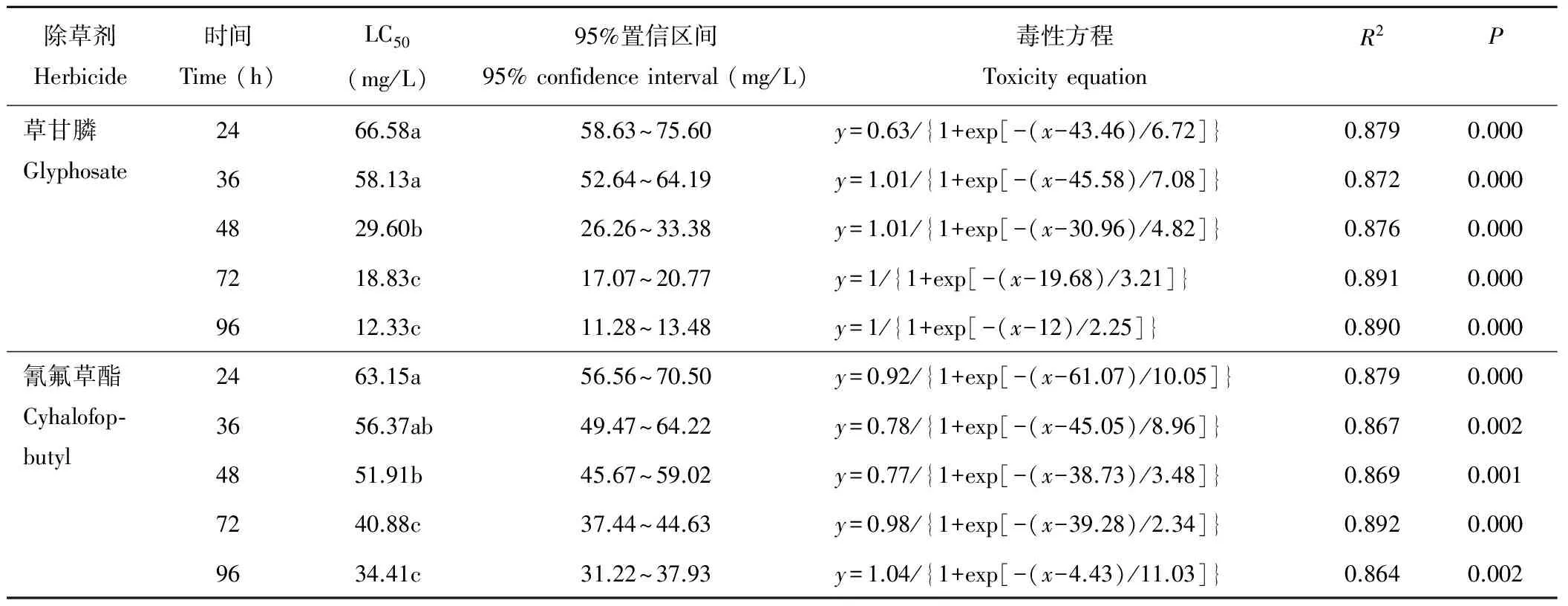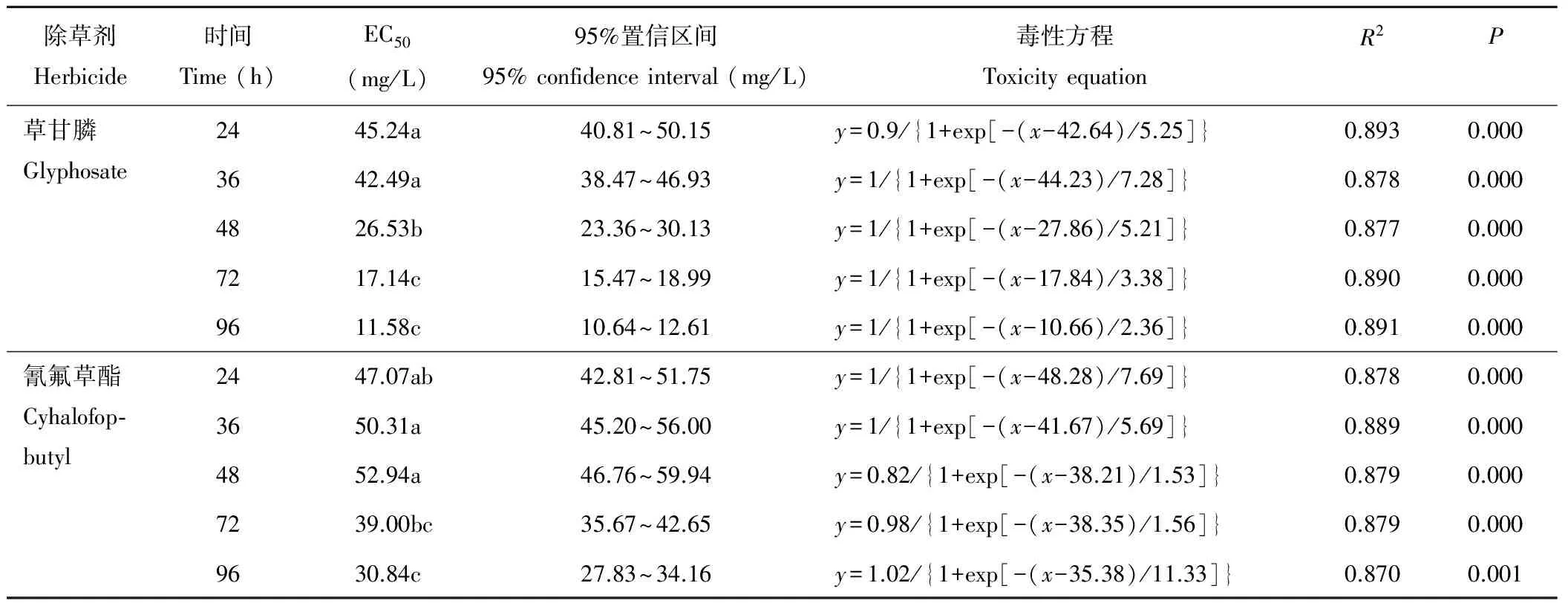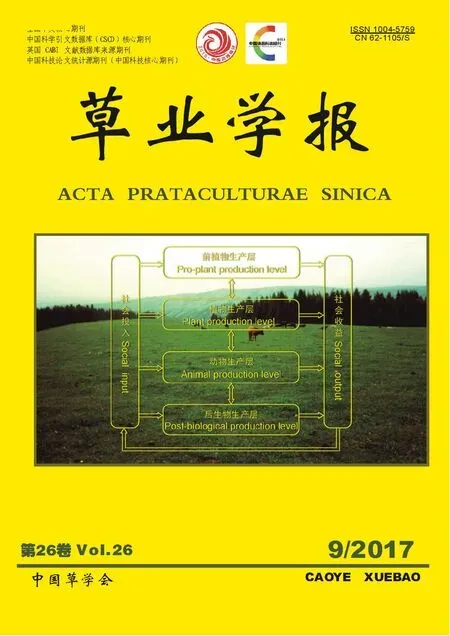草甘膦与氰氟草酯对隆线溞的急性毒性研究
李佳,袁玲
(西南大学资源环境学院,重庆 400716)
草甘膦与氰氟草酯对隆线溞的急性毒性研究
李佳,袁玲*
(西南大学资源环境学院,重庆 400716)
在水生食物链中,水溞是连结植物、微生物和动物的关键成员。草甘膦与氰氟草酯被广泛用于防除水生和稻田杂草,研究它们对水溞的毒性,有益于人们关注使用除草剂对水体生态系统的影响。试验以标准水体监测生物——隆线溞(Daphniacarinata)单克隆为材料,研究草甘膦和氰氟草酯对其泳动能力、存活率和趋光性的影响。结果表明,两种除草剂对隆线溞均有明显毒性,草甘膦对隆线溞24, 48和96 h的半致死浓度(LC50)分别为66.58, 29.60和12.33 mg/L,为田间常规用药量的0.15%~0.81%;氰氟草酯对隆线溞24, 48和96 h的LC50依次是63.15, 51.91和34.41 mg/L,为田间常规用药量的17.21%~31.58%。两种除草剂显著影响隆线溞的泳动能力和趋光指数。隆线溞接触草甘膦和氰氟草酯3 h后,导致其趋光指数显著改变的浓度分别是4.59和14.20 mg/L,分别为常规用药量的0.06%和7.10%。因此,草甘膦和氰氟草酯对水溞的毒性大,对水生食物链的影响不可忽视。利用水溞趋光性可快速、灵敏地监测除草剂使用后的水体生物毒性。
草甘膦; 氰氟草酯; 隆线溞; 急性毒性
除草剂是现代农业广泛使用、高效防除杂草的化学试剂,其用量大于杀虫剂、杀菌剂和杀螨剂三者之和,占目前农药生产总量的55%左右[1]。我国除草剂用量大,环境负荷重。在20世纪90年代中期,我国化学除草剂使用面积达4000万hm2,占播种面积的1/4[2]。到2014年我国除草剂原药产量达180.35万t,其中出口80.60万t,国内使用量约100万t[3]。由此可见,我国除草剂用量极大,其主要用于农地、森林和水域(如鱼塘、河道及湖泊等)[4]。
在水体生态系统中,鱼类以浮游动物——水溞(Daphnia)为食,而水溞以水藻和微生物为食,故水溞是水生食物链的关键成员。环境中的除草剂影响动物和微生物新陈代谢和生长发育。研究发现,氯嘧磺隆减低土壤微生物数量,影响土壤微生物的结构和多样性[5];丁草胺严重影响蝌蚪的生长发育,产生遗传毒性[6];阿特拉津对家蚕的生长发育速度、眠蚕体重有显著影响,且在蚕体内有一定积累作用[7]。丁草胺和丁苄混剂对淡水螺、福寿螺、坑螺这3种水生动物的呼吸作用有显著的抑制作用,严重影响其存活率[8]。乙草胺能够引起雄性小鼠睾丸组织病理损伤、精子畸形率增高、睾丸细胞酶LDH、SDH活性下降、睾丸细胞周期紊乱和细胞凋亡率升高,具有生殖毒性[9]。草甘膦和精喹禾灵对蚯蚓用滤纸法染毒48 h后,其LC50值分别为546.4和638.7 μg/cm2[10]。但是,关于除草剂对水溞生长发育、运动能力和趋光性的影响尚待研究。
除草剂大量用于水体除草,施入土壤的除草剂也通过降雨、径流和淋溶进入水体[11]。但除草剂对水体生态系统的影响知之甚少,开展除草剂对水体生物的影响研究,对科学使用除草剂具有重要的现实意义。草甘膦广泛用于控制一年和多年生的各种杂草,是当前生产和使用量最大的农药品种之一[12-14],也是河岸、湿地等水体防除如空心莲子草(Alternantheraphiloxeroides)、水葫芦(Eichhorniacrassipes)等恶性杂草使用最广泛的除草剂[15-16]。氰氟草酯(R-2-[4(4-氰基-2-氟苯氧基)苯氧基]-丙酸丁酯)是稻田广泛使用的一种内吸传导性除草剂,用于杀灭稗草(Echinochloacrusgalli)、千金子(Leptochloachinensis)等杂草[17]。水溞不仅是水生食物链的关键成员,而且也是国际公认的标准试验生物,广泛用于监测水体中的有害物质,评价水体生态系统的健康质量[18]。本研究选择常用的草甘膦和氰氟草酯为试验材料,以我国长江流域的常见水溞——隆线溞(D.carinata)为试验生物,研究这两种代表性的除草剂对水溞的生物毒性,为除草剂的科学使用提供理论依据。
1 材料与方法
1.1试验时间
2015年12月15日至2016年2月20日,逐代培养并筛选出生长良好且趋光性强的优良隆线溞;2016年2月21日至2016年4月10日,进行多次预备试验而确定试验处理的草甘膦和氰氟草酯浓度;2016年4月11日至2016年4月15日,准备试验用品及调试试验装备;2016年4月16日至2016年4月23日,进行正式试验。
1.2试验材料
1.2.1除草剂 除草剂分别为41%草甘膦异丙胺盐水剂和10%氰氟草酯水乳剂,均购于中国农业科学院植物保护研究所,保存于4~10 ℃的冰箱中。
1.2.2水溞 选取自主选育的、趋光性强的隆线溞为试验材料。原种采集于重庆三峡库区的自然水体,经多代孤雌生殖、纯化,获得单克隆生物株,保存于西南大学资源环境学院水溞实验室。
在光强1200 lx、光周期12 h/d、温度(20±0.5) ℃的条件下,用充分充氧曝气脱氯的自来水培养隆线溞,每日清晨8:00投喂新鲜的斜生栅藻,培养至4 d龄期备用。
1.2.3试验用水 标准毒物的稀释水为ISO6341-1989人工标准水(以下简称标准水)[19],其组成为:0.294 g/L CaCl2·H2O,0.123 g/L MgSO4·7H2O,0.065 g/L NaHCO3,0.006 g/L KCl, 用预先充氧至饱和的去离子水(20 ℃)配制,用1 mol/L HCl或NaOH调节pH至7.80,静置24 h后使用。
1.3试验设计及过程描述
1.3.1除草剂对隆线溞存活率及活动能力的影响 采用单因子随机设计,在多次预备试验的基础上(参照两种除草剂说明书的用药浓度,草甘膦8.2 g/L,氰氟草酯0.2 g/L),根据改良寇氏法[20],每种除草剂按等比设置处理浓度梯度,组间比值为1.6,设置6个试验处理:草甘膦浓度设置为0(CK),12.30,19.68,31.57,50.43,80.77 mg/L,氰氟草酯浓度设置为0(CK), 15.0, 24.0, 38.4, 61.4, 98.3 mg/L。每处理重复6次,每个重复随机选取10只健康水溞,即每个处理共有60只水溞参与试验。
试验在光强1200 lx 、光周期12 h/d、温度(20±0.5) ℃的条件下进行。将试验用的水溞于200 mL ISO标准水中润洗3次,每次5 min,再置于100 mL不同浓度的除草剂溶液中,在12, 24, 36, 48, 72和96 h 观察隆线溞存活及活动情况。在观察期间的条件设置同常规培养。
隆线溞活动受抑制标准为:轻微扰动溶液15 s,触角可活动,但个体不能泳动;死亡判断标准为:溞体沉入水底,轻轻转动容器无任何反应[21]。
1.3.2除草剂对隆线溞趋光性的影响 隆线溞培养、试验条件和除草剂浓度设置(表1)、处理数、重复数,以及每次重复所用的水溞数均与1.2.1相同。每次重复即随机选取10只隆线溞,置于100 mL不同浓度的除草剂溶液中,1200 lx光照培养3 h。然后将隆线溞转入水溞趋光测定装置[22-23],暗适应5 min后,在1200 lx光照下,刺激10 min,从第6 min开始,每1 min记录各光区内的隆线溞数目[23]。
1.4测定指标及其计算方法
用改良寇氏法[20]计算隆线溞半抑制浓度(EC50)和半致死浓度(LC50);水溞趋光指数(phototaxical index,Ip) 的计算公式如下[21,24]:
Ip=(U-L)/(U+M1+M2+L)
式中:U、M1、M2、L分别代表观察装置[17]上、中上、中下和下部的水溞数。
1.5数据处理
用Excel 2013对试验数据进行基本计算以及图表的制作;用SigmaPlot 12.5软件进行毒性方程的拟合;用SPSS 17.0软件进行方差分析,多重比较采用Duncan法,显著水平设为P<0.05。
2 结果与分析
2.1除草剂对隆线溞的致死作用
由表1可知,草甘膦和氰氟草酯均与隆线溞致死率存在着明显的剂量-效应关系,可用y=a/{1+exp[-(x-c)/b]}方程表示。草甘膦对隆线溞24, 36, 48, 72和96 h的LC50分别为66.58, 58.13, 29.60, 18.83和12.33 mg/L,LC50(24 h)分别是LC50(48 h)和LC50(96 h)的2.3和5.4倍,即草甘膦的LC50随着时间推移而降低。氰氟草酯对隆线溞24, 36, 48, 72和96 h的LC50依次是63.15, 56.37, 51.91, 40.88和34.41 mg/L,LC50(24 h)分别比LC50(48 h)和LC50(96 h)高21.7%和83.5%。在36 h及以后的时段,草甘膦的LC50显著低于氰氟草酯。
2.2除草剂对隆线溞活动能力的抑制作用
由表2可知,草甘膦和氰氟草酯处理可显著降低隆线溞的活动能力,也存在着明显的剂量-效应关系,可用y=a/{1+exp[-(x-c)/b]}方程表示。前者对隆线溞24, 36, 48, 72和96 h的EC50分别为45.24, 42.49, 26.53, 17.14和11.58 mg/L,即随着时间推移,草甘膦的EC50显著降低;后者对隆线溞的EC50依次是47.07~52.94 mg/L(24~48 h), 39.00 mg/L (72 h)和30.84 mg/L(96 h),即24~48 h无显著变化,随后显著降低。此外,在各个时段,草甘膦的EC50均小于氰氟草酯。

表1 草甘膦和氰氟草酯对隆线溞致死率的影响Table 1 Effect of glyphosate and cyhalofop-butyl on the death rate of D. carinata
注:LC50值由改良寇氏法[20]计算,y表示累计致死率(%),x表示除草剂浓度(mg/L)。同列不同字母表示差异显著(P<0.05)。
Note:LC50is calculated by modified Karber’s method[20],yrepresents the cumulative lethality (%), andxrepresents the concentration of herbicides (mg/L). Different letters in the same column indicate significant difference (P<0.05).

表2 草甘膦和氰氟草酯对隆线溞活动能力的影响Table 2 Effect of glyphosate and cyhalofop-butyl on the movement of D. carinata
注:EC50值由改良寇氏法[20]计算,y表示累计抑制率(%),x表示除草剂浓度(mg/L)。同列不同字母表示差异显著(P<0.05)。
Note:EC50is calculated by modified Karber’s method[20],yrepresents the cumulative inhibition ratio (%), andxrepresents the concentration of herbicides (mg/L). Different letters in the same column indicate significant difference (P<0.05).
2.3除草剂对隆线溞趋光性的影响
2.3.1草甘膦 由图1可知,隆线溞趋光指数Ip随着草甘膦浓度增大而显著降低。在无草甘膦的对照中,Ip为0.3,加入草甘膦之后,隆线溞趋光指数Ip和草甘膦浓度之间的关系可由方程y=10-4x2-0.023x+0.355,R2=0.973(y表示Ip;x表示除草剂浓度, mg/L)表示,由此可计算出当草甘膦浓度为4.59 mg/L(施用浓度的1/1787)时,Ip显著降低;当草甘膦浓度从19.68 mg/L增加至31.57 mg/L时,Ip由正变负;当草甘膦浓度为80.77 mg/L时,隆线溞的趋光性极弱,Ip仅为-0.858,相对于对照组减少了1.158个Ip单位。
2.3.2氰氟草酯 由图2可知,隆线溞趋光指数Ip也随着氰氟草酯浓度增大而显著降低。在无氰氟草酯的对照中,Ip为0.3,加入氰氟草酯之后,隆线溞趋光指数Ip和氰氟草酯浓度之间的关系可由方程y=10-4x2-0.023x+0.308,R2=0.990(y表示Ip;x表示除草剂浓度, mg/L)表示,由此可计算出当氰氟草酯浓度为14.2 mg/L(为施用浓度的1/14)时,Ip显著降低;当氰氟草酯浓度增加至24.0 mg/L时,Ip由正变负,降至-0.2;当氰氟草酯浓度为98.3 mg/L时,隆线溞趋光性很弱,Ip为-0.65,相对于对照组降低了0.95个Ip单位。

图1 草甘膦对隆线溞趋光性的影响Fig.1 Effect of glyphosate on the phototaxis of D. carinata

图2 氰氟草酯对隆线溞趋光性的影响Fig.2 Effect of cyhalofop-butyl on the phototaxis of D. carinata
不同字母代表差异显著(P<0.05)。下同。Different letters mean significant difference atP<0.05. The same below.
3 讨论
在除草剂登记品种中,草甘膦占总用量的60.37%[25],不仅用于农田、果园、绿地,而且也大量用于防治鱼塘、河道及湖泊中的水生空心莲子草、水葫芦等,施用剂量高于推荐用药量3~4倍[26],施用后在水体中含量极高。氰氟草酯主要用于稻田,防除稗草、千金子、牛筋草(Eleusineindica)等恶性禾本科杂草,并可有效防除对二氯喹啉酸、磺酰脲类和酰胺类除草剂产生抗性的杂草[27]。在2006-2011年,氰氟草酯的市场销售量年增长10.80%;2011-2013年的增长率高达23.55%[28]。因此,草甘膦和氰氟草酯剂是目前使用广、用量大、递增快,也是用于水域环境最具代表性的除草剂[29],研究它们对水溞的影响有重要意义。
试验以隆线溞作为监测生物,设置不同浓度的草甘膦和氰氟草酯处理,研究了隆线溞的生理反应,包括24,36,48,72和96 h的LC50和EC50,以及3 h的趋光行为[22,30-32]。结果表明,在不同时段,二者对隆线溞的存活和泳动能力存在着明显的剂量-效应关系,草甘膦对隆线溞的LC50(48 h)为29.60 mg/L,氰氟草酯的LC50(48 h)是51.91 mg/L,说明两种除草剂对隆线溞均有较强毒性,施用浓度越高毒性愈强,草甘膦的毒性大于氰氟草酯,类似对鱼、虾、蛙类等水生和两栖动物的危害。吴长兴等[33](2011)研究发现,氰氟草酯对泽蛙蝌蚪高毒。Modesto等[34](2010)发现,5 mg/L 草甘膦制剂能使鱼类血液中的血球容积增大,红细胞和白细胞数量增加,体内的抗氧化酶活性改变,产生毒害作用。徐怡等[35](2010)的研究表明,10%草甘膦水剂对克氏原螯幼虾产生毒害作用。Relyea[36](2008)及Lajmanovich等[37](2011)报道,3.80 mg/L草甘膦可使蝌蚪大量死亡,1.85 mg/L草甘膦制剂在施药48 h后降低青蛙体内乙酰胆碱酯酶和谷胱甘肽酶活性。说明草甘膦使用浓度在1.85~5.00 mg/L范围对水生动物鱼、虾、青蛙、蝌蚪等产生毒害。刘晓伟等[38](2012)也研究表明,低浓度的草甘膦对多刺裸腹溞具有毒性[LC50(48 h)=26.29 mg/L]。值得注意的是,草甘膦对隆线溞的LC50(96 h)仅为常规使用浓度(8.2 g/L)的0.15%,氰氟草酯的LC50(96 h)是常规使用浓度(0.2 g/L)的17.21%,说明在水体使用除草剂对水溞产生较大危害,威胁其生存。在水体生态系统中,水溞不仅是水生食物链的关键成员,而且还与水体生产力密切相关。因此,除草剂的使用对水生态系统的影响不可忽视。
隆线溞食物广,适应性强,易于培养,繁殖生长快,短时间内可获大量群体,且对毒物反应灵敏,故在水质监测中,水溞是国际上公认的标准试验生物[39]。因此,吴永贵等[40]、杨静等[41]和郭晓燕[42]利用隆线溞Ip检测水体中的铜、镉、汞、五氯酚钠、拟除虫菊酯,判断其对隆线溞的生物毒性。在本研究中,水溞EC50(24 h)和LC50(24 h)分别为45.24~66.58 mg/L(草甘膦)和47.07~63.15 mg/L(氰氟草酯),而在3 h时,使Ip发生显著改变的浓度仅为4.59 mg/L(草甘膦)和14.20 mg/L(氰氟草酯),分别为常规用药量的0.06%和7.10%,说明测定Ip不仅耗时短,而且灵敏度高。此外,水溞趋光性易于观察,若将可视技术与电子计算机结合可仪器化测定Ip,在线监测除草剂使用后的水体生物毒性。
4 结论
草甘膦和氰氟草酯对隆线溞的运动抑制和致死率存在着明显的剂量-效应关系,二者的常规使用浓度极显著高于LC50,对隆线溞有较强毒性,且草甘膦的毒性显著大于氰氟草酯。
草甘膦和氰氟草酯使隆线溞的趋光指数(3 h)显著改变的浓度显著低于EC50和LC50(24 h),利用水溞趋光性可快速、灵敏地监测水体中的除草剂。
References:
[1] Zhu J. Studies on Photodegradation of Emamectin Benzoate and its Effect on the Insecticidal Activity[D]. Nanjing: Nanjing Agricultural University, 2010. 朱军. 甲氨基阿维菌素苯甲酸盐的光解及对杀虫活性影响的研究[D]. 南京: 南京农业大学, 2010.
[2] Feng C C, Ma H. Application status and challenges of herbicides. Jiangsu Agricultural Sciences, 2014, 42(8): 111-113. 冯程程, 马红. 除草剂应用现状及挑战. 江苏农业科学, 2014, 42(8): 111-113.
[3] Yang Y J. Where will Chinese pesticide industry go under the new normal. Marketing: Means of Agricultural Production and Market, 2015, (8): 74-76. 杨益军. 新常态下我国农药行业会往哪走. 营销界: 农资与市场, 2015, (8): 74-76.
[4] Lu X, Zhao B Z, Zhang J B,etal. Summary of nature and environmental behavior of the herbicide glyphosate. Chinese Journal of Soil Science, 2005, 36(5): 785-790. 卢信, 赵炳梓, 张佳宝, 等. 除草剂草甘膦的性质及环境行为综述. 土壤通报, 2005, 36(5): 785-790.
[5] Sheng Y. Effects of Long-term Residual Herbicide Chlorimuron-ethyl on Soil Microbial Ecology[D]. Harbin: Northeast Agricultural University, 2011. 盛宇. 长残留除草剂氯嘧磺隆对土壤微生物生态的影响[D]. 哈尔滨: 东北农业大学, 2011.
[6] Lin L. Study of Butachlor on Tadpoles of Three Anuran Species Toxic Effects[D]. Fuzhou: Fujian Normal University, 2010. 林玲. 丁草胺对三种无尾两栖类蝌蚪毒理学效应的研究[D]. 福州: 福建师范大学, 2010.
[7] Chen J Q, Dai X Y, Xu S Q. Effects of environmental herbicide atrazine hormone on the growth and development of silkworm. China Sericulture, 2007, 28(4): 13-17. 陈剑秋, 戴璇颖, 徐世清. 环境激素除草剂阿特拉津对家蚕生长发育的影响. 中国蚕业, 2007, 28(4): 13-17.
[8] Zhao L, Luo S M, Li H S,etal. Eco-toxicological effects of four herbicides on typical aquatic snail pomacea canaliculata and crown conchs. Acta Ecologica Sinica, 2011, 31(19): 5720-5727. 赵兰, 骆世明, 黎华寿, 等. 不同浓度下四种除草剂对福寿螺和坑螺的生态毒理效应. 生态学报, 2011, 31(19): 5720-5727.
[9] Hu W J. The Study on Reproductive Toxicity of Herbicide Acetochlor in Male Mice[D]. Changchun: Jilin University, 2010. 胡伟军. 除草剂乙草胺对雄性小鼠生殖毒性的研究[D]. 长春: 吉林大学, 2010.
[10] Wang F F, Zheng M M, Liu S H,etal. Acute toxicity and oxidative stress of two herbicides on earthworm eisenia fetida. Asian Journal of Ecotoxicology, 2014, 9(6): 1210-1218. 王飞菲, 郑梦梦, 刘树海, 等. 两种除草剂对蚯蚓的急性毒性及氧化胁迫效应. 生态毒理学报, 2014, 9(6): 1210-1218.
[11] Ni Y. Toxic Effects and Mechanism of Mesotrione onMicrocystissp. andScenedesmusquadricauda[D]. Nanchang: Nanchang University, 2014. 倪妍. 硝磺草酮对微囊藻和四尾栅藻的毒性效应及致毒机理研究[D]. 南昌: 南昌大学, 2014.
[12] Hua N Z. Progress in research and application of nonselective herbicide glyphosate varieties, dosage forms and additives. Pesticide Market News, 2014, (27): 20-23. 华乃震. 非选择性除草剂草甘膦品种、剂型及助剂研究应用进展. 农药市场信息, 2014, (27): 20-23.
[13] Tu Y Q, Yuan H Z. Scientific use of pesticides on the basis of pesticide application technology. Journal of Plant Protection, 1996, 23(3): 275-280. 屠予钦, 袁会珠. 农药的科学使用问题与农药应用工艺学. 植物保护学报, 1996, 23(3): 275-280.
[14] Klevorn T B, Wyse D L. Effect of soil temperature and moisture on glyphosate and photoassimilate distribution in quackgrass (Agropyronrepens). Weed Science, 1984, 32(3): 402-407.
[15] Wang C. Test of glyphosate inAlternantheraphiloxeroides. Anhui Forestry Science and Technology, 2006, (5): 40. 王超. 草甘膦防除空心莲子草试验. 安徽林业科技, 2006, (5): 40.
[16] You Y, Wang C F, Wang J,etal. Glyphosate isopropylamine control of water hyacinth and the chemical residue in water. Fujian Journal of Agricultural Sciences, 2007, 22(2): 167-171. 游泳, 王长方, 王俊, 等. 草甘膦异丙胺盐水剂防除水葫芦效果及其在水中的残留. 福建农业学报, 2007, 22(2): 167-171.
[17] Nie Z J, Gu X J, Cai S,etal. Isolation of a cyhalofop-butyl-degrading bacterium and its degradation characteristics. Chinese Journal of Applied and Environmental Biology, 2011, 17(6): 869-875. 聂志娟, 顾谢军, 蔡舒, 等. 一株除草剂氰氟草酯降解菌的分离鉴定与降解特性. 应用与环境生物学报, 2011, 17(6): 869-875.
[18] Hermens J, Broekhuyzen E, Canton H,etal. Quantitative structure activity relationships and mixture toxicity studies of alcohols and chlorohydrocarbons: effects on growth of daphnia magna. Aquatic Toxicology, 1985, 6(3): 209-217.
[19] Wu Y, Hong R, Fu T. Use inhibition rate of vertical movement ability of daphnia carinata as an indicator of chromium acute bio-toxicity. Energy Procedia, 2012, 16(16): 383-390.
[20] Li C P, Wu M Y, Wang H Y. LC50calculated by Kochi, Probit analysis and linear regression methods. Progress in Veterinary Medicine, 2012, 33(9): 89-92. 李翠萍, 吴民耀, 王宏元. 3种半数致死浓度计算方法之比较. 动物医学进展, 2012, 33(9): 89-92.
[21] Wu Y G, Lin C X, Yuan L. Characteristics of six cladocerans in relation to ecotoxicity testing. Ecological Indicators, 2007, 7(4): 768-775.
[22] Wu Y G. Biomonitoring Toxicity of Nitrogen,Phosphorus and Heavy Metals in Water and Soil by the Phototactic Behavior of Daphnia[D]. Chongqing: Southwest Agricultural University, 2004. 吴永贵. 利用水溞趋光行为监测水体及土壤中氮磷与重金属的生物毒性[D]. 重庆: 西南农业大学, 2004.
[23] Chen Y N, Yuan L. Acute toxicity of coptis chinensis rhizome extracts toDaphniacarinata. Environmental Science, 2015, 36(10): 3892-3895. 陈亚楠, 袁玲. 黄连根茎浸提物对隆线溞的急性毒性作用. 环境科学, 2015, 36(10): 3892-3895.
[24] Meester L D. Genotype, fish-mediated chemical, and phototactic behavior in daphnia magna. Ecology, 1993, 74(5): 1467-1474.
[25] Tian Z H, Shen G H. Status of non-crop herbicide registration in China. Weed Science, 2015, (1): 61-64. 田志慧, 沈国辉. 我国非农用除草剂产品登记现状概述. 杂草科学, 2015, (1): 61-64.
[26] Zhu G N, Lou Z Y, Sun J H. Study on toxicity and environmental safety of glyphosate to aquatic organisms. Journal of Zhejiang University: Agriculture & Life Sciences, 2000, 26(3): 309-312. 朱国念, 楼正云, 孙锦荷. 草甘膦对水生生物的毒性效应及环境安全性研究. 浙江大学学报: 农业与生命科学版, 2000, 26(3): 309-312.
[27] Zhang W N. The demand of cyhalofop-butyl in rice herbicide market is on the rise. Shandong Pesticide Information, 2014, (5): 35. 张为农. 氰氟草酯在水稻除草剂市场需求呈上升趋势. 山东农药信息, 2014, (5): 35.
[28] Bai Y L. General situation of world pesticide market and new product development. Journal of China Agrochemicals, 2012, (1): 5-22. 柏亚罗. 世界农药市场概况及新产品研发. 中国农药, 2012, (1): 5-22.
[29] Li F. Development and export dynamics of glyphosate industry in China[C]//Report of China Formaldehyde Industry Association Annual Conference and Domestic and International Technology Exchange in 2009. Suzhou: 2009. 李峰. 我国草甘膦工业的发展与出口动态[C]//2009年中国甲醛行业协会年会暨国内外技术交流会报告集. 苏州: 2009.
[30] Sarma S S S, Nandini S, Flores J L G. Effect of methyl parathion on the population growth of the rotiferBrachionuspatulus, (O. F. Müller) under different algal food (Chlorellavulgaris) densities. Ecotoxicology & Environmental Safety, 2001, 48(2): 190-195.
[31] Mangas-Ramírez E, Sarma S S, Nandini S. Combined effects of algal (Chlorellavulgaris) density and ammonia concentration on the population dynamics ofCeriodaphniadubiaandMoinamacrocopa(Cladocera). Ecotoxicology and Environmental Safety, 2002, 51(3): 216-222.
[32] Gama-Flores J L, Sarma S S S, Nandini S. Acute and chronic toxicity of the pesticide methyl parathion to the rotiferBrachionusangularis, (Rotifera) at different algal (Chlorellavulgaris) food densities. Aquatic Ecology, 2004, 38(1): 27-36.
[33] Wu C X, Zhao X P, Wu S G,etal. Toxicity and risk of herbicide cyhalofop-butyl onRanalimnocharis. Acta Agriculturae Zhejiangensis, 2011, 23(4): 771-775. 吴长兴, 赵学平, 吴声敢, 等. 氰氟草酯对泽蛙蝌蚪毒性及风险. 浙江农业学报, 2011, 23(4): 771-775.
[34] Modesto K A, Martinez C B R. Effects of roundup transorb on fish: hematology, antioxidant defenses and acetylcholinesterase activity. Chemosphere, 2010, 81(6): 781-787.
[35] Xu Y, Liu Q G, Hu Z J,etal. Acute toxicity of ten pesticides to larval red swamp crayfish procambarus clarkia. Asian Journal of Ecotoxicology, 2010, 5(1): 50-56. 徐怡, 刘其根, 胡忠军, 等. 10种农药对克氏原螯虾幼虾的急性毒性. 生态毒理学报, 2010, 5(1): 50-56.
[36] Relyea R A. The lethal impact of roundup on aquatic and terrestrial amphibians. Ecological Applications, 2008, 15(4): 1118-1124.
[37] Lajmanovich R C, Attademo A M, Peltzer P M,etal. Toxicity of four herbicide formulations with glyphosate on rhinella arenarum (anura: bufonidae) tadpoles: B-esterases and glutathione S-transferase inhibitors. Archives of Environmental Contamination & Toxicology, 2011, 60(4): 681-689.
[38] Liu X W, Xi Y L. Toxicological effect of paraquat and glyphosate on cladoceranMoinamacrocopa. Chinese Journal of Ecology, 2012, 31(8): 1984-1989. 刘晓伟, 席贻龙. 百草枯和草甘膦对多刺裸腹溞的毒性效应. 生态学杂志, 2012, 31(8): 1984-1989.
[39] Shao L, Huang J G, Yuan L. The effect of cadmium on reproductive ability of three species of daphnia. Journal of Southwest University: Natural Science Edition, 2010, 32(5): 102-106. 邵蕾, 黄建国, 袁玲. 重金属镉对三种水溞繁殖能力的影响. 西南大学学报: 自然科学版, 2010, 32(5): 102-106.
[40] Wu Y G, Xiong Y, Lin C X. Evaluating the biotoxicity effect of copper by the phototactic behaviour ofDaphniacarinataand LC50. Journal of Yunnan Agricultural University: Natural Science Edition, 2006, 21(5): 657-662. 吴永贵, 熊焱, 林初夏. 铜对隆线溞趋光行为的抑制作用及其致死效应. 云南农业大学学报: 自然科学版, 2006, 21(5): 657-662.
[41] Yang J, Yuan L, Tang Y. Monitoring sodium pentachlorophenate and cadmium in aquatic solutions by phototactic behavior ofDaphniacarinataclone. Acta Scientiae Circumstantiae, 2006, 26(6): 1011-1015. 杨静, 袁玲, 唐毅. 利用隆线溞趋光行为检测水体中五氯酚钠和镉的研究. 环境科学学报, 2006, 26(6): 1011-1015.
[42] Guo X Y. Monitoring Pyrethroids and Hg2+in Water by Phototaxis ofDaphnia[D]. Chongqing: Southwest University, 2007. 郭晓燕. 利用水溞趋光性监测水中的拟除虫菊酯类农药和汞[D].重庆: 西南大学, 2007.
Acutetoxicitystudyofglyphosateandcyhalofop-butyltoDaphniacarinata
LI Jia, YUAN Ling*
CollegeofResourcesandEnvironment,SouthwestUniversity,Chongqing400716,China
Daphnia is a key organism in the food chains of plants, microbes, and animals in aquatic ecosystems. Glyphosate is widely applied to crop fields, orchards, green land, and water, and accounts for about 60% of registered herbicides in China. Cyhalofop-butyl is widely used to controlEchinochloacrusgalliin paddy fields. The use of these two herbicides has increased markedly in recent years in China. Therefore, it is important to investigate the toxicity of glyphosate and cyhalofop-butyl to zooplankton to understand their effects on aquatic ecosystems. In this study,Daphniacarinata, a standard bio-monitor of water quality, was cultivated in dechlorinated tap water and fed withScenedesmusobliquusat (20±0.5) ℃ under light at 1200 lx supplied by fluorescent lamps. Four-day-oldD.carinatawere incubated in solutions containing glyphosate or cyhalofop-butyl at different concentrations. The acute toxicity of these two herbicides to the movement, survival, and phototaxis ofD.carinatawas evaluated. Both herbicides were toxic toD.carinata. The semi-lethal concentration (LC50) of glyphosate in 24 h, 48 h, and 96 h was 66.58, 29.60, and 12.33 mg/L, respectively, and that of cyhalofop-butyl was 63.15, 51.91, and 34.41 mg/L, respectively. These dosages represented only 0.15%-0.81% (glyphosate) and 17.21%-31.58% (cyhalofop-butyl) of those applied in the field. Both glyphosate and cyhalofop-butyl had significant adverse effects on the swimming ability and phototaxis index ofD.carinata. The concentrations causing significant changes in the phototaxis index at 3 h were 4.59 mg/L for glyphosate and 14.20 mg/L for cyhalofop-butyl; these concentrations corresponded to 0.06% and 7.10% of the field dosage, respectively. These results showed that glyphosate and cyhalofop-butyl are very toxic to daphnia. Therefore, their effects on the aquatic food chain should not be ignored. Changes in the phototaxis ofD.carinatain response to herbicides at low concentrations may serve as an index of herbicide bio-toxicity in fresh water.
glyphosate; cyhalofop-butyl;Daphniacarinata; acute toxicity
10.11686/cyxb2016474
http://cyxb.lzu.edu.cn
李佳, 袁玲. 草甘膦与氰氟草酯对隆线溞的急性毒性研究. 草业学报, 2017, 26(9): 148-155.
LI Jia, YUAN Ling. Acute toxicity study of glyphosate and cyhalofop-butyl toDaphniacarinata. Acta Prataculturae Sinica, 2017, 26(9): 148-155.
2016-12-10;改回日期:2017-03-15
科技部973课题(2013CB127405)资助。
李佳(1992-),女,四川阆中人,在读硕士。E-mail:459319608@qq.com*通信作者Corresponding author. E-mail:lingyuanh@aliyun.com

